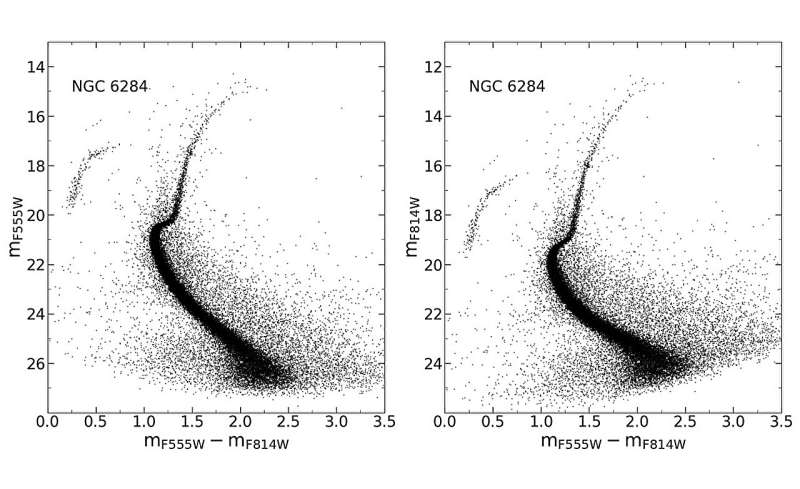November 7, 2023 report
This article has been reviewed according to Science X's editorial process and policies. Editors have highlighted the following attributes while ensuring the content's credibility:
fact-checked
preprint
trusted source
proofread
Globular cluster NGC 6284 inspected by astronomers

Italian astronomers have used the Hubble Space Telescope (HST) to perform high-resolution optical observations of a poorly studied globular cluster known as NGC 6284. Results of the observational campaign, published October 26 on the pre-print server arXiv, shed more light on the properties and nature of this cluster.
Globular clusters (GCs) are collections of tightly bound stars orbiting galaxies, perceived as natural laboratories enabling studies on the evolution of stars and galaxies. Detailed studies of these objects could help astronomers better understand the formation history and evolution of early-type galaxies, as their origin seems to be closely linked to periods of intense star formation.
Discovered in 1784, NGC 6284 (also known as GCL 53 or ESO 518-SC9) is a Galactic GC estimated to be at least 11 billion years old. Although the cluster has been known about for more than two centuries, many of its parameters still remain uncertain or unknown. Previous observations have found that NGC 6284 is a mid-metallicity GC about 50,000 light years away, possibly associated with the Milky Way's thick disk.
Recently, a team of astronomers led by Dan Deras of the University of Bologna in Italy decided to investigate NGC 6284 with HST in order to gain more insights into its properties.
"High-resolution Hubble Space Telescope (HST) optical observations have been used to perform the deepest photometric study of the poorly studied Galactic globular cluster NGC 6284," the researchers wrote in the paper.
By conducting high-resolution HST observations, the team obtained the first high-quality color-magnitude diagram (CMD) of NGC 6284, extending down to about six magnitudes below its main sequence turn-off. This allowed them to properly characterize the innermost regions of the cluster.
The observations show that the center of gravity of NGC 6284 is displaced by 1.5–3 arcseconds from the values reported by previous studies. The density profile of the investigated GC shows a steep central cusp, which suggests that NGC 6284 is a post-core collapse (PCC) cluster.
Furthermore, the study found that the distance to NGC 6284 is about 43,000, thus the cluster is closer to Earth than previously thought. The core radius and half-mass radius of NGC 6284 were measured to be 2.15 and nine light years, respectively. The concentration parameter of the cluster was calculated to be 1.54. The astronomers noted that the values obtained are typical for highly-evolved GCs that already experienced core collapse.
Based on the HST observations, the authors of the paper estimate that NGC 6284 is 13.3 billion years old. The metallicity of this cluster was found to be at a level of -1.36, while its absolute reddening was measured to be 0.32. The results are consistent with previous findings.
More information: Dan Deras et al, A Photometric in-depth look at the core-collapsed globular cluster NGC 6284, arXiv (2023). DOI: 10.48550/arxiv.2310.17503
Journal information: arXiv
© 2023 Science X Network


















